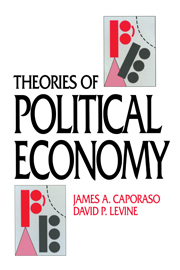Book contents
- Frontmatter
- Contents
- Preface
- Theories of political economy
- Introduction
- 1 Politics and economics
- 2 The classical approach
- 3 Marxian political economy
- 4 Neoclassical political economy
- 5 Keynesian political economy
- 6 Economic approaches to politics
- 7 Power-centered approaches to political economy
- 8 State-centered approaches to political economy
- 9 Justice-centered theories
- Conclusion
- Bibliography
- Index
4 - Neoclassical political economy
Published online by Cambridge University Press: 05 June 2012
- Frontmatter
- Contents
- Preface
- Theories of political economy
- Introduction
- 1 Politics and economics
- 2 The classical approach
- 3 Marxian political economy
- 4 Neoclassical political economy
- 5 Keynesian political economy
- 6 Economic approaches to politics
- 7 Power-centered approaches to political economy
- 8 State-centered approaches to political economy
- 9 Justice-centered theories
- Conclusion
- Bibliography
- Index
Summary
The time since the publication of Adam Smith's Inquiry into the Nature and Causes of the Wealth of Nations in 1776 to the present day spans over two hundred years. Although there are important elements of continuity from Smith to the present world, neoclassical economics is not just a modern, updated version of classical political economy. The beginnings of the neoclassical system are placed in the 1870s with the rise of marginalist economics. Before the 1870s economics as a system of thought was dominated by the classical agenda: growth, distribution, and the labor theory of value. After the 1870s, this agenda changed in important ways, although it did not change overnight.
To simplify a complex chapter in this history of economic thought, the marginalist revolution succeeded in doing two things. First, it advanced a theory of value grounded in the intensity of subjective feelings (subjective utility theory). And second, it developed the marginal calculus as a powerful conceptual and methodological tool. The upshot of these two developments was that, over the span of the next three to four decades, the emerging neoclassical consensus succeeded in replacing the labor theory of value with one grounded in subjective utility and placed the ideas of “marginal product” and “final demand” at the center while elbowing into the wings the concepts of total product and total demand. With these new ideas gathering momentum as they spread during the last quarter of the nineteenth century, the economy came to be thought of less in terms of material production and reproduction and more as a logic of human action.
- Type
- Chapter
- Information
- Theories of Political Economy , pp. 79 - 99Publisher: Cambridge University PressPrint publication year: 1992

